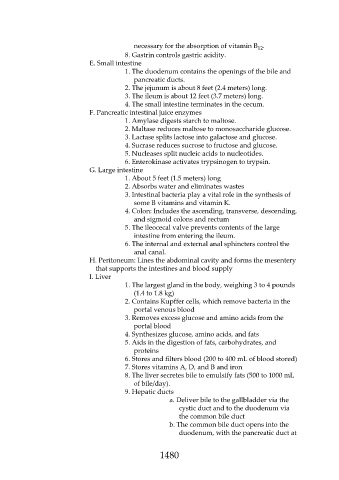Page 1480 - Saunders Comprehensive Review For NCLEX-RN
P. 1480
necessary for the absorption of vitamin B .
12
8. Gastrin controls gastric acidity.
E. Small intestine
1. The duodenum contains the openings of the bile and
pancreatic ducts.
2. The jejunum is about 8 feet (2.4 meters) long.
3. The ileum is about 12 feet (3.7 meters) long.
4. The small intestine terminates in the cecum.
F. Pancreatic intestinal juice enzymes
1. Amylase digests starch to maltose.
2. Maltase reduces maltose to monosaccharide glucose.
3. Lactase splits lactose into galactose and glucose.
4. Sucrase reduces sucrose to fructose and glucose.
5. Nucleases split nucleic acids to nucleotides.
6. Enterokinase activates trypsinogen to trypsin.
G. Large intestine
1. About 5 feet (1.5 meters) long
2. Absorbs water and eliminates wastes
3. Intestinal bacteria play a vital role in the synthesis of
some B vitamins and vitamin K.
4. Colon: Includes the ascending, transverse, descending,
and sigmoid colons and rectum
5. The ileocecal valve prevents contents of the large
intestine from entering the ileum.
6. The internal and external anal sphincters control the
anal canal.
H. Peritoneum: Lines the abdominal cavity and forms the mesentery
that supports the intestines and blood supply
I. Liver
1. The largest gland in the body, weighing 3 to 4 pounds
(1.4 to 1.8 kg)
2. Contains Kupffer cells, which remove bacteria in the
portal venous blood
3. Removes excess glucose and amino acids from the
portal blood
4. Synthesizes glucose, amino acids, and fats
5. Aids in the digestion of fats, carbohydrates, and
proteins
6. Stores and filters blood (200 to 400 mL of blood stored)
7. Stores vitamins A, D, and B and iron
8. The liver secretes bile to emulsify fats (500 to 1000 mL
of bile/day).
9. Hepatic ducts
a. Deliver bile to the gallbladder via the
cystic duct and to the duodenum via
the common bile duct
b. The common bile duct opens into the
duodenum, with the pancreatic duct at
1480

